Hey Lykkers! Have you ever wondered what life is like for zebras beyond those striking black-and-white stripes?
Believe it or not, these animals have rich social lives filled with fascinating herds, clear hierarchies, and genuine friendships. Let’s dive into the world of zebras and uncover the secrets behind their social behavior!
The Social Lives of Zebras: Herds, Hierarchies, and Friendships
Zebras aren’t just solitary animals wandering the plains—they’re highly social creatures who rely on strong bonds and group dynamics to survive. Their lives revolve around herds, where each member plays an important role in keeping the group safe and thriving.
Herd Life: Safety in Numbers
A zebra herd usually consists of one dominant male, called a stallion, several females, known as mares, and their young foals. These family groups can range from just a handful of zebras to larger clusters when several herds join together temporarily during migration or at water sources.
The herd offers protection: predators like lions and hyenas find it much harder to single out one zebra when many eyes and ears are watching. Zebras use loud barks and snorts to alert the herd if danger is near, creating a real “neighborhood watch” vibe on the savannah.
Hierarchies: Who’s the Boss?
Within the herd, there’s a clear social structure. The stallion is the protector and decision-maker, responsible for defending the group from rival males and leading them to food and water. Among the mares, there’s also a pecking order, often determined by age, size, and personality.
Interestingly, younger stallions without their own harems form bachelor groups, where they bond and compete for a chance to lead their own herd one day. These bachelor herds are often a mix of playful camaraderie and serious power struggles.
Zebra Friendships: More Than Just Herdmates
Zebras don’t just tolerate each other—they form genuine friendships. They often groom each other by nibbling and licking around the neck and back, which not only helps keep pests away but also strengthens social bonds. Some zebras develop “best friend” pairs that stick close together, protect each other, and even show signs of distress when separated.
These friendships are crucial, especially for young zebras learning the ropes of herd life. Mares sometimes babysit each other’s foals, showing a level of cooperation and trust that’s truly remarkable in the wild.
Why Does Zebra Social Life Matter?
The social system of zebras is key to their survival. It helps them avoid predators, find resources, and raise healthy young. Plus, these relationships reduce stress and improve overall herd health.
In fact, researchers studying zebras have noticed that stronger social bonds often mean higher survival rates, which shows just how important friendship and teamwork are in the wild.
Final Thoughts
Next time you see a group of zebras grazing or galloping across the plains, remember there’s a whole world of social drama and deep friendships behind those stripes. Zebras teach us that even in the wild, connection and community make all the difference.
If you want to learn more cool animal social behaviors or dive deeper into the life of zebras, just say the word, Lykkers!


